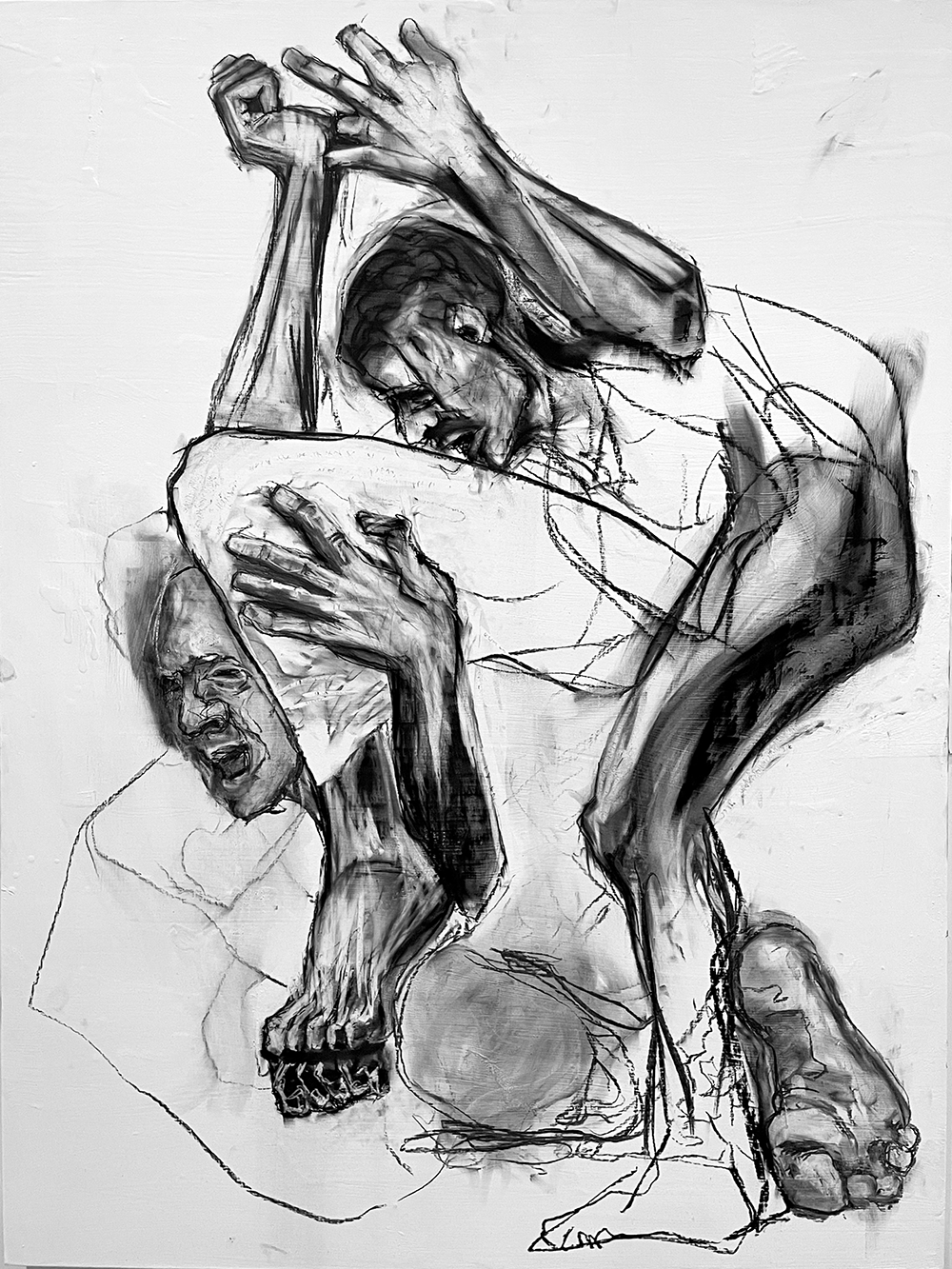Box office superhero origin stories and their sequels—from Sam Rami’s Spider-man (2002), Christopher Nolan’s Batman Begins (2005) to Jon Favreau’s Iron Man (2008)—have grossed millions of dollars from the repeat viewings of fans who hunger to know the real story: how it all began, and how it will end. Digging deeper (though with an unknown future and a miniscule budget) are the interrogating notions of early man in David John Attyah’s masterful multi-media installation that mirrors a natural history museum, and its artifacts of fanciful excavation. In this museum the artist deconstructs the prehistoric hetero-normal myth-truth-lies lens through which queerness is understood or misconstrued. In an exhibition that includes installation, works on paper, and hand-weaving, there is much to be deciphered.
Three Queens with Single Foot and Double Twins with Single Heart (both 2022) skillfully demonstrate that Attyah embraces what many artists have abandoned for more contemporary practices: human figures interpreted in stylistic accuracy. Akin to figurative masters like Charles White, Philip Pearlstein, Paul Cadmus, David Alfaro Siqueiros, and Egon Schiele, his contoured line reflects unflinching chiaroscuro confidence. The apprehension in the eyes, the intense sadness in facial expressions, and the minimized personal space suggests a symbiotic if standoffish connection. These wrestling males are nearly conjoined, with one reaching for the ragged floating heart, suggesting a hostile world where profit is gained through human marginalization.

David John Attyah, Red bone, 2021. Knotted hemp, animal bone, encaustic wax, 8 x 4 x 1.5 in. Image courtesy of the artist.
The magnificent Rock Painting (2021) is a richly textured faux Jurassic Rorschach artifact fused by hide glue, plywood, plaster rocks, spackle and wax drawings, and it is completely convincing. Attyah assaults the notion of symbolic strength found in mineral matter. Rock Painting is exactly what museums exist to collect, preserve, reinforce and maintain for society’s conditioned noncritical understanding of value, civilization and aesthetic purity. Unsurprisingly, these organizations are connected to foundations that fund projects connected to the myopic interests of gatekeepers. This understood, Attyah’s Reclining Curio (2021) all wobbling legs and lamb bones, is an absolute Whistler’s Mother.
The artist’s Wunderkammer is a separate room where walls are shape-shifted to thaw frozen paradigms. For example, Skull Cabinet (2021) consists of ornamental lamp of wax, hair, bone, wands of wood and gold leaf, teeth of glazed porcelain, plaster, oil, and reclaimed legs. Hearkening to the anthropology of culture, excavation and preservation, this work implicitly asks how would society look if it was realized that Queerness has always existed, that such human experience was not just a recently discovered UFO to be misunderstood, feared, stereotyped, and judged? Attyah’s space is truly reimagined. This cabinet of curiosities is completed by Wall curio featuring various codpieces and hearth doilies (2021). The eight lacy items are stacked and illumined in a white framed hearth that suggests a tender, private but unabashedly romantic highboy. Ultimately, The Museum of Selective Homo Amnesia does more than simply challenge assumptions of history and culture, this exhibition demands that society replace its memory card with a fresh one.











David’s show sounds incredible, I can’t wait to see it!
We are so pleased to have David’s remarkable artwork at the Advocate and Gochis Galleries at the Los Angeles LGBT Center’s Village at Ed Gould Plaza in Hollywood.
The exhibition has been extended through Saturday, December 3rd. The gallery is open Wednesdays 5 to 7 pm, Thursdays 3 to 5 pm, and Saturdays 11 to 2 pm. You may also visit by appointment by contacting mwalker@lalgbtcenter.org. The address is: 1125 N. McCadden Place, Los Angeles 90038 (one block east of Highland, just north of Santa Monica Blvd.) Hope to see you here!